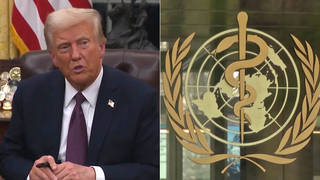
President Biden has declared an end to the COVID-19 national emergency, but people living with long COVID say the pandemic is far from over. The Centers for Disease Control and Prevention found nearly one in five people infected with COVID-19 go on to experience symptoms of long COVID. We speak to science writer Ryan Prior about the movement to expand research and resources for those with long COVID, and his own experience living with the chronic illness. Prior is the author of The Long Haul and writes the “Patient Revolution” for Psychology Today.
Transcript
AMY GOODMAN: This is Democracy Now!, democracynow.org, The War and Peace Report. I’m Amy Goodman.
This week, President Biden signed legislation that declared an end to the COVID-19 national emergency. But the pandemic is ongoing for millions living with long COVID. The Centers for Disease Control and Prevention found nearly one in five people infected with COVID-19 go on to experience symptoms of long COVID. One of them is Democratic senator, former vice-presidential candidate Tim Kaine.
SEN. TIM KAINE: I got COVID in March 2020. My case was mild, and by early April 2020 I was fine, except for one lingering symptom. When I first got COVID, I noticed that all of my nerve endings were tingling, 24/7. Feels like they’ve been dipped in an Alka-Seltzer, like they’ve all had five cups of coffee. I didn’t talk about it for a while, because I thought I would wake up one day and that symptom would be gone. But that didn’t happen. Three years later, the symptoms haven’t gotten worse, but that it also hasn’t gotten better. I’ve since learned that my long COVID symptom is a significantly possible aftereffect of this viral infection. And while it likely won’t get worse, it may never go away. I wish I didn’t have long COVID, but having it connects me with people across the country who do.
AMY GOODMAN: Virginia Senator Kaine reintroduced the CARE for Long COVID Act with Senators Ed Markey and Tammy Duckworth last month, but funding for research and resources remains limited. This is Terri Wilder, chair of the #MEAction Minnesota, testifying in March before the Minnesota House Health Finance and Policy Committee.
TERRI WILDER: It’s estimated that 10 to 20% of all Minnesotans who got COVID have experienced long COVID symptoms. That suggests that there are potentially hundreds of thousands of Minnesotans with long COVID, who are experiencing significant impacts to their health, functionality and quality of life. And that includes children, adolescents and young adults.
It’s also estimated that around 50% of people with long COVID meet the clinical criteria for the disease I have, myalgic encephalomyelitis. And this is a disabling and complex disease that impacts multiple body systems. It’s a neurological disease, according to the World Health Organization.
I also want to highlight that COVID-19 has disproportionately impacted Black, Indigenous and other nonwhite communities, as well as low-income, rural, disabled and elder populations.
AMY GOODMAN: For more, we’re joined in Atlanta by Ryan Prior, journalist-in-residence at The Century Foundation, author of The Long Haul. His new article for The Nation magazine is headlined “The Long COVID Revolution.” His new column for Psychology Today is called “Patient Revolution.” He’s also on the #MEAction board of directors.
Welcome to Democracy Now!, Ryan. First of all, explain more fully what ME is, how it relates to long COVID. And, I mean, you’re not only writing about this; you are living this every day. Talk about your life experience.
RYAN PRIOR: Yeah. Thanks for having me.
ME refers to myalgic encephalomyelitis, as Terri Wilder was talking about in the segment. And “myalgic” refers to pain; “encephalomyelitis” refers to inflammation of the brain and the spinal cord. It also goes by the term “chronic fatigue syndrome,” so sometimes it’s referred to as ME/CFS. So, it’s a neuroimmune disease that has no approved treatments from the FDA. And many patients become disabled and can’t work.
I’m fortunate that I’m in the — even though some of the worst experiences of my life made me better, and I’m now in the situation where I have a more mild case, and I am able to work. But I use my voice as a journalist, as an advocate, and working for a think tank now, working in public policy, to pursue ideas and situations and telling the story of millions who can’t tell their own stories and who can’t live out their dreams.
And the primary symptom of ME/CFS, and really the primary symptom of long COVID, is called post-exertional malaise, which means that people do minor exertions, which could be taking a shower or walking down the block on their street, and that can leave them bedridden or sick for days, if not weeks, afterwards. So, it makes it impossible to participate in society, if you can’t do basic functions.
AMY GOODMAN: So, Ryan, talk about what it means for President Biden to say that the COVID national emergency is over, what this means for millions of long COVID sufferers. What do you think needs to be done?
RYAN PRIOR: Yeah. So, for people who have had chronic illnesses for decades prior to the pandemic, many felt that long COVID was a moment where their needs were going to be met. And there has been tremendous power from the chronic illness community that has helped embolden the long COVID movement, this long COVID revolution that we talk about in the piece, that so many groups have come together in this moment of tremendous post-viral illness in ways that they never had before.
And so, the message that our chronic illness community would have to President Biden is to acknowledge the fact that there’s millions missing, millions of people missing from their lives, and there’s millions of dollars that are currently still missing from the research that needs to be done, and really the drug repurposing trials that need to be done to urgently find new treatments to help people with long COVID.
As a society, we came together with a public-private partnership for Operation Warp Speed, creating vaccines at the fastest rate and distributing them to the entire population faster than any vaccine in history. We now have an opportunity to do a similar thing for long COVID, to do an Operation Warp Speed. There’s dozens of drugs that could work for ME/CFS and for long COVID, and we need much greater urgency from the National Institutes of Health and from others to get these treatments tested. And many of those probably will work for treating the long, disabling symptoms of long COVID.
And this is a moment, maybe, if we can actually learn to characterize and research and treat a number of different diseases, not just long COVID, but long COVID is a way into understanding, like I mentioned before, ME/CFS, another disease, postural orthostatic tachycardia syndrome, POTS, which means that people’s blood — heart rates rise rapidly upon standing, and people faint. That’s another major characteristic of long COVID. So, there’s so many other chronic illnesses that are post-infection chronic illnesses. And so long COVID represents a time for all of us, as a society, to understand the number of people who are living with invisible disabilities, these millions missing who are homebound or bedbound, and this is their moment to sort of be brought back into the mainstream of medicine.
AMY GOODMAN: Ryan Prior, in your book, your columns, your articles, you draw on the history of HIV/AIDS activists with ACT UP, who changed healthcare policy, and disability activists, who crawled up the steps of the U.S. Capitol to demand passage of the American Disabilities Act. Talk about this kind of action, what you call a “patient revolution.”
RYAN PRIOR: Yes. And so, my colleague Fiona Loewenstein and I wrote a piece for The Nation. Fiona is the author of a book called The Long COVID Survival Guide, and I’ve also written a book that chronicles the rise of patient groups, primarily online. And our piece for The Nation starts with a #MillionsMissing protest outside the White House held one day after the president said on 60 Minutes that the pandemic was over. This was last September.
But I think this protest was indicative of a larger history of people with diseases that were not well recognized by the medical establishment, who came together to rally for a cure, rally for treatments. ACT UP and the Treatment Action Group in the 1980s and the 1990s are kind of the hallmark of what health advocacy in the wake of an epidemic or a pandemic looks like, and the same with those who campaigned for the Americans with Disabilities Act that was passed in 1990. So, this new generation has stepped up, thinking about how to advocate for chronic illnesses. This protest outside the White House was part of this noble tradition of patients speaking on behalf of those that can’t speak for themselves.
And one note I’ll have here is that because people with ME/CFS are so disabled, and they experience post-exertion malaise, it’s hard to get a — even a small protest is a major accomplishment in our community, because so much of it has to happen over social media, and people are too sick to go out.
But I think that this is a step forward. And bringing more media attention to this protest, and really to this larger movement, is something that policymakers need to understand. And Senator Kaine’s CARE for Long COVID Act is one of a number of different solutions. This Operation Warp Speed for long COVID treatments is another idea that I think that these need to be acted on. And patients will be gathering next week for the Long COVID Advocacy Week on Capitol Hill, telling their members of Congress to move these bills forward and to greenlight millions, if not billions, of more dollars that could be used to treat this disease.
If we don’t act quickly to research it and to cure it and to treat it, or to provide disability accommodations or disability benefits for those who are sick, the long-term impact of this, of long COVID, is of a scale and scope that’s hard to understand. Harvard economist David Cutler estimates that there’d be a $3.7 trillion — “trillion” with a T — impact on the U.S. economy for years to come, if we don’t address long COVID now. So, a major, urgent approach to research for long COVID is really important for helping people unlock their dreams who might not be able to live the lives that they intended.
AMY GOODMAN: Well, Ryan Prior, I want to thank you so much for coming in to the studio in Atlanta, Georgia, especially given the price you will pay for this, that you yourself are suffering from long COVID, but how important it is to share this information. And we’ll continue to cover this much understood, not often talked about issue of long COVID. Ryan Prior, journalist-in-residence at The Century Foundation, wrote the book The Long Haul. I’m Amy Goodman. Thanks so much for joining us.













Media Options